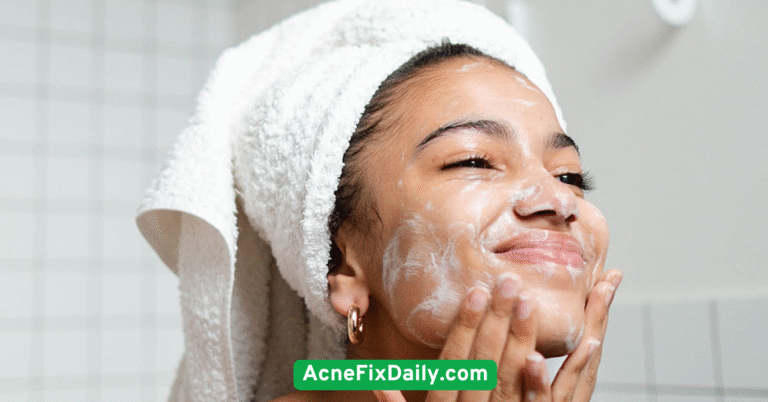15 Gentle Skincare Tips for Oily Skin
Oily skin can often feel like a constant battle—shiny patches, enlarged pores, and frequent breakouts seem like endless challenges. But here’s the good news: oily skin doesn’t have to be a skincare nightmare. With the right gentle and mindful skincare routine, you can balance oil production, reduce breakouts, and enjoy a fresh, matte complexion that lasts all day!If you’ve been struggling with oily skin, you’re not alone. Studies show that around 50% of people worldwide deal with oily or combination skin at some point in their lives. The key to managing oily skin is to be gentle, not harsh. Over-washing or using aggressive products only makes your skin overproduce oil, causing more problems. That’s why this article shares 15 gentle, budget-friendly skincare tips designed specifically for oily skin. You’ll learn how to keep your skin clean, hydrated, and balanced without stripping away its natural protection.Ready to embrace a glowing, oil-controlled complexion? Let’s dive right in!
1. Use a Mild, Sulfate-Free Cleanser
Choosing the right cleanser is the foundation of any skincare routine, especially for oily skin. Sulfate-based cleansers might foam well but tend to strip your skin’s natural oils, causing it to overcompensate by producing even more oil.Switching to a mild, sulfate-free cleanser can gently remove dirt and excess sebum without disrupting your skin’s delicate barrier. Look for formulas with natural soothing ingredients like aloe vera or chamomile, which calm inflammation and balance oil production.Cleanse your face twice daily—morning and night—but avoid harsh scrubbing. Instead, use your fingertips in gentle, circular motions to help unclog pores and leave your skin feeling fresh without tightness or dryness.

2. Incorporate a Lightweight, Oil-Free Moisturizer
Many people with oily skin skip moisturizers altogether, fearing they’ll add more shine. But hydration is essential for all skin types—even oily skin! The secret is to opt for a lightweight, oil-free moisturizer that hydrates without clogging pores.Look for moisturizers labeled “non-comedogenic” and formulated with water-based or gel textures. Ingredients like hyaluronic acid and glycerin attract moisture and lock it in without heaviness.Applying moisturizer after cleansing helps regulate oil production, preventing your skin from becoming dehydrated and producing excess sebum to compensate. This balance can significantly reduce shine and improve skin texture over time.

3. Apply a Mattifying Primer Before Makeup
If you wear makeup, a mattifying primer can be your best friend. These primers help control excess oil, smooth skin texture, and keep makeup looking fresh for hours.Choose primers with ingredients like silica, kaolin clay, or niacinamide, which absorb oil and reduce pore visibility. Apply a thin layer on your face after moisturizing but before foundation or tinted moisturizer.Using a mattifying primer not only enhances your makeup’s longevity but also prevents oil buildup, which can lead to clogged pores and breakouts.

4. Use Toners with Witch Hazel or Salicylic Acid
Toners often get overlooked, but they’re crucial for oily skin. A gentle toner helps remove residual dirt, tighten pores, and rebalance skin’s pH after cleansing.Witch hazel is a natural astringent that reduces oiliness and inflammation, while salicylic acid is a beta-hydroxy acid (BHA) that penetrates deep into pores to exfoliate and clear out excess sebum.Avoid toners with high alcohol content as they can dry out your skin and trigger more oil production. Instead, look for alcohol-free formulas containing these gentle, effective ingredients.

5. Exfoliate Gently Once or Twice a Week
Exfoliation removes dead skin cells that clog pores and lead to blackheads and breakouts. However, over-exfoliating or using harsh scrubs can irritate oily skin, increasing oil production and sensitivity.Stick to gentle exfoliation once or twice a week using chemical exfoliants like salicylic acid or lactic acid. These acids help dissolve dead skin and clear pores without abrasive scrubbing.Chemical exfoliants also promote cell turnover, revealing smoother, brighter skin while helping to minimize pore size and oiliness.

6. Incorporate Niacinamide in Your Routine
Niacinamide, a form of Vitamin B3, is a skincare superstar for oily skin. It regulates sebum production, strengthens the skin barrier, reduces redness, and helps shrink enlarged pores.You can find niacinamide in serums, moisturizers, and toners. Consistent use of niacinamide not only balances oiliness but also improves overall skin texture and resilience.It’s gentle and suitable for all skin types, making it a perfect addition to your daily skincare regimen.

7. Use Clay Masks Weekly
Clay masks are excellent for oily skin because they absorb excess oil, detoxify impurities, and refine pores. Kaolin and bentonite clays are especially effective and gentle.Apply a clay mask once a week to keep shine at bay and deep-clean your skin. Avoid leaving the mask on until it’s completely dry to prevent over-drying.Regular use of clay masks can help control oiliness while keeping your skin feeling fresh and smooth.

8. Avoid Over-Washing Your Face
It’s tempting to wash oily skin multiple times a day to get rid of shine. But over-washing strips your skin of its natural oils, triggering increased oil production as your skin tries to compensate.Stick to washing your face twice daily and use lukewarm water—not hot—to prevent irritation. Between washes, you can use blotting papers or mattifying powders to manage excess oil without disrupting your skin’s balance.Remember, less is more when it comes to cleansing oily skin!

9. Use Sunscreens Specifically Formulated for Oily Skin
Sun protection is non-negotiable, but many sunscreens can feel greasy or cause breakouts on oily skin.Look for non-comedogenic, oil-free sunscreens with a matte finish. Ingredients like zinc oxide or titanium dioxide provide physical sun protection without clogging pores.Apply sunscreen daily—even on cloudy days—to protect your skin from harmful UV rays that can worsen oiliness and cause premature aging.

10. Stay Hydrated and Maintain a Balanced Diet
Healthy skin starts from within! Drinking plenty of water throughout the day helps flush out toxins and keeps your skin hydrated, reducing the chance of excess oil production.A balanced diet rich in antioxidants, vitamins, and minerals supports clear, healthy skin. Incorporate foods like leafy greens, berries, nuts, and fatty fish, which provide essential nutrients for skin health.Avoid excessive sugar, fried foods, and dairy if they trigger your breakouts, as these can increase inflammation and oiliness.

11. Incorporate Antioxidants Like Vitamin C
Vitamin C is a powerful antioxidant that brightens skin, reduces inflammation, and supports collagen production. It also helps reduce oiliness by regulating sebum production.Use a stable Vitamin C serum in your morning routine after cleansing and before moisturizing. Look for formulas with L-ascorbic acid or sodium ascorbyl phosphate for best results on oily skin.Vitamin C also protects your skin against environmental damage and promotes a radiant, even complexion.

12. Avoid Heavy Makeup Products
Heavy, oil-based makeup can clog pores and worsen oily skin problems. Instead, opt for lightweight, non-comedogenic foundations or tinted moisturizers.Mineral makeup is a great option for oily skin as it allows your skin to breathe and often contains oil-absorbing ingredients.Always remove makeup thoroughly at the end of the day to prevent buildup and breakouts.

13. Manage Stress for Better Skin Health
Stress is a sneaky trigger for oily skin and acne flare-ups. When you’re stressed, your body produces more cortisol, a hormone that can increase oil production.Incorporate stress-management techniques into your routine, like yoga, meditation, deep breathing, or even short walks outside.Not only will this improve your skin, but it also benefits your overall well-being.

14. Use Blotting Papers for Quick Oil Control
Blotting papers are a quick and affordable way to absorb excess oil throughout the day without disrupting your makeup or skincare.Keep a pack handy in your bag and gently press the paper on oily areas like the T-zone. This simple trick helps maintain a fresh, matte look without washing or applying more products.Look for blotting papers made of natural fibers for the best results.

15. Regularly Clean Your Phone and Pillowcases
Your phone screen and pillowcases come into frequent contact with your skin and can transfer dirt, oil, and bacteria, leading to clogged pores and breakouts.Clean your phone screen daily with alcohol wipes and change pillowcases at least once a week.Good hygiene habits like these support your skincare routine and help keep oily skin under control.

Conclusion
Managing oily skin doesn’t have to mean harsh products and complicated routines. By adopting these 15 gentle skincare tips, you can effectively control excess oil, minimize pores, and enjoy a clearer, healthier complexion.Remember, consistency is key. Give your skin time to adjust and respond to the new routine. Hydrate, protect, and treat your skin with kindness, and it will thank you!Start today by choosing one or two tips from this list and gradually build a skincare routine tailored just for your oily skin. And don’t forget—healthy skin is beautiful skin!





